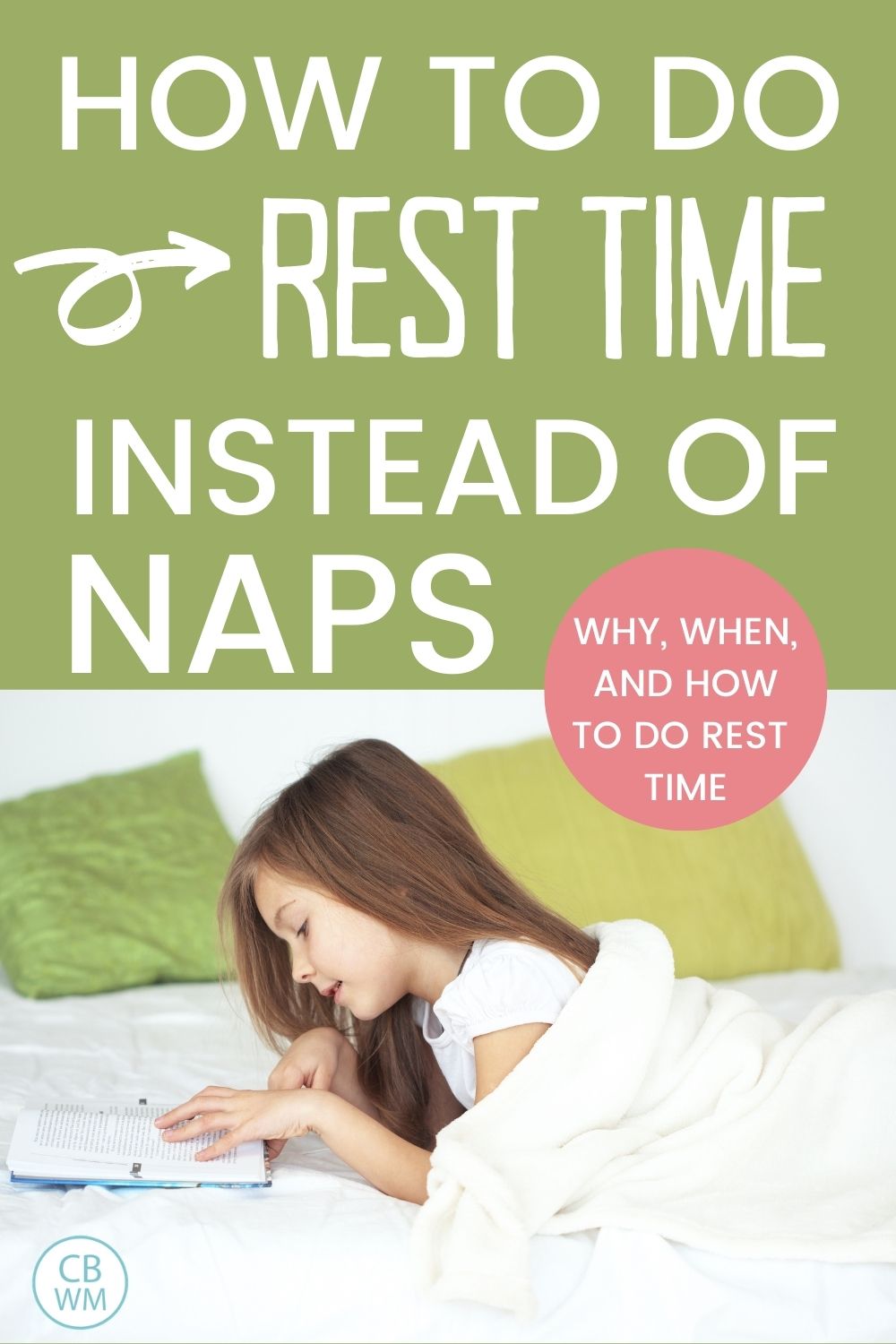As your little one gets older, the need for daily nap decreases, but that doesn’t mean your child will not need some time to rest each afternoon.

Once your child is ready to drop the afternoon nap, that does not mean that your days of a bit of quiet time in the afternoon are over.
Even if a child doesn’t need to sleep each afternoon, the child will greatly benefit from some quiet time to rest and be alone.
Your child will be able to recharge and it can help him have a happy attitude through the rest of the day.
>>>Read: How to Know When Your Child is Ready to Stop Napping
Brinley did her first official rest time at age 4.
She was so thrilled to have something that wasn’t a nap. She was not ready to be rest time at full time. She still needed naps some days. But it worked to do it some days each week.
So what should rest time look like?
Post Contents
WHAT IS REST TIME or QUIET TIME?
Rest time, or quiet time (I will use those words interchangeably), is when your child no longer needs a daytime nap each day.
Your kiddo can sleep if needed. The beauty of rest time is since your child is in a quiet, comfortable place, sleep can happen if needed that day.
Rest time is a time when your child goes to a restful place and lies down.
It is a time for kids to have downtime each day but does not need to be sleep.
You will still want similar rules to nap time. Your child should stay in bed (or on the couch–see below for more on that) until you get him or until the clock hits a certain time if your child can tell time.
You can give your child books to look at. Some people like to use audio books or play some soothing music quietly.
I always either leave blinds open or leave the light on low if the room has a dimmer so the child can see the books. I don’t want bright light on because I want the child to sleep if he gets tired.
This time gives families a break in the day. It is a good time for siblings to get some alone time. It is very helpful for moms with newborns or babies to take care of.
It can be a helpful tool for homeschooling families and work from home moms alike.
Quiet Time Rules
You will want some rules and boundaries during this time. Some good ones to have are:
- Stay in bed
- You may read or do something quietly
- If you feel sleepy, you should sleep
- Stay in rest time until ___ (either you give a time, set a timer, or you get your kiddo)
WHY BOTHER HAVING QUIET TIME EACH DAY?
The body and brain still need rest each day.
A child moves at a hundred miles per hour from the time he wakes up each day.
A rest time gives him the chance to fall asleep if sleep is needed and if not, it just gives him a chance to sit and be rather still.
Children often need more sleep during growth spurt times, which still happen frequently through childhood, so rest time offers that daily break to have that nap happen when it is needed.
It also gives you a break each day to do what you need with it. Rest yourself. Take a shower. Make some phone calls. Maybe you need it for time to be able to focus on a baby or an older sibling.
WHAT AGE CAN REST TIME START?
Rest time, or quiet time, is typically started with four year olds.
On Becoming Preschoolwise states that dropping this nap starts around four years of age, though it greatly depends on the sleep needs of individual children (page 100). Some children start this at age three; others wait until closer to five.
Before that, you might have days that look like rest time, but still call it “nap time” with your child. If you are totally confident that your three year old does not need naps anymore, you might call it rest time as a three year old. But read through this post and be sure your child is ready.
Rest time can be done by children (and adults!) of all ages.
When my kids were younger, we would often have a family rest time on Sundays when our church was in the morning hours.
Since my children go to school, we didn’t have it each day.
We don’t have it in the summer each day, either, but if someone is having an emotional day during the summer or on a Saturday, we will have a rest time.
That child always emerges happier and more pleasant.
WHEN SHOULD IT BE IN YOUR ROUTINE?
Rest time should be in the afternoon right about when the nap used to be. It can be as short as 30 minutes. It might be as long as 60 minutes.
If your child falls asleep, you will want to get him up when the nap would have ended. You might give him an extra 30-45 minutes, but you don’t want rest time nap to lead to no sleeping at night.
If your child doesn’t sleep, watch behavior that evening and know you might need an early bedtime and put your child to bed 30-60 minutes early if he seems like he needs it.
WHERE SHOULD REST TIME BE?
Rest time is ideally still in your child’s bed.
That isn’t always the best place when you add in all factors, however.
If your child shares a room with a sibling, you will probably want the child doing rest time to do quiet time somewhere else and the napping child to be in the room.
If his bed is not an option, find a place in the home that can be quiet for your child.
Your child could do rest time in the family room on the couch if it is a place your child will not see you.
Another great location option is your bed.
The great thing about rest time is that on those days your child is tired, your child can take a nap, so you want rest time to be in a location where the child can fall asleep if needed.
You also want your child to really be able to rest and not be distracted by what is going on in the house. He may not need daytime sleep, but he does need a chance to get some rest from the busyness of life.
SHOULD YOU DO A SLEEP ROUTINE?
When it was time for rest time, I did an abbreviated sleep routine before quiet time with my kids.
Instead of two stories, we read one with Brinley.
With my older kids, I usually just took them in and had them do rest time without much of a routine at all. I always had a baby to take care of when the older kids were doing rest time, so I liked to keep the routine short.
BRAYDEN’S PROCESS
Here is Brayden’s path on moving from one nap a day to rest time each day.
First, it kind of started around three, not four.
At three, Brayden started sleeping less and less, but his disposition after a missed nap told me he wasn’t ready to not be taking naps.
I had him sleep in my room instead of his room since his room overlooked the road, where he had lots to look at instead of sleep. That helped a lot.
Naps went back to happening most days.
Then the real process started around 3.5 years old.
An overall difficulty for us is that Brayden really does not like to sleep. You couldn’t just tell him to “sleep if he needs it”; according to him, he never needed it.
He was really good about staying in his bed. I had to teach him to tell time so he would stay in bed and not get up to check if it was time to get out.
He had his books and his clock and he stayed in bed.
By four years and three months old, he didn’t take a nap most days.
He took a nap about 3 days a week. He stayed in bed for 1.5-2 hours each day at this age. I once tried shortening his time in bed, but it didn’t go well. He needed his time in there to decompress and just relax.
We were definitely on our way to having no naps, but we were not there yet. It was a long process.
Rest Time Recap
-This is a chance to rest and be quiet each afternoon
-Move to official “rest time” around age 4
-Have this time each day at the same time nap was happening
-Have it in a quiet space
-Have set rules and expectations
-Give your child a way to measure time and know when he can get up
-It is okay for your child to have quiet activities to do during this time
-If your child does fall asleep, wake up by a certain time so you do not disrupt nighttime sleep
-You might need to do early bedtimes some days if your kiddo is too tired
CONCLUSION
Rest time is a great chance for everyone in the family to get a little break. You will be so happy you used that in your daily schedule, and it will be of benefit to your child as well!
Related Posts
- How to Know When Your Child is Ready to Stop Napping
- Everything You Need to Know About Dropping Naps
- Dropping Naps: A Quick Reference
- Preschoolers and Naps
- When Do Kids Stop Napping
- When To Drop Rest Time

This post originally appeared on this blog September 2009 and September 2016

